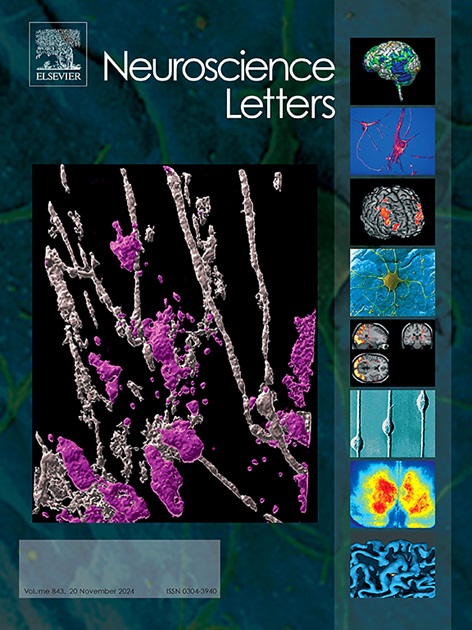Characterization of the N-terminal region of Crtac1B/LOTUS, an endogenous Nogo receptor-1 antagonist, required for secretion and soluble function
IF 2.5
4区 医学
Q3 NEUROSCIENCES
引用次数: 0
Abstract
Lateral olfactory tract usher substance (LOTUS), also known as cartilage acidic protein-1B (Crtac1B), is a potent endogenous antagonist of Nogo receptor type-1 (NgR1). LOTUS exists in both membrane-bound (m-LOTUS) and soluble (s-LOTUS) forms. m-LOTUS inhibits NgR1 by binding to its C-terminal domain (UA-EC domain), thereby blocking ligand interactions, whereas s-LOTUS disrupts NgR1 signaling by interfering with its interaction with the p75 co-receptor. However, the molecular characteristics of s-LOTUS, including the functional domains required for secretion and NgR1 binding, remain unclear.
In this study, we identified the N-terminal 35Met-532Pro region as essential for s-LOTUS secretion. While N-type glycosylation patterns remained unchanged, differences in intracellular localization with the Golgi apparatus were observed between secretory and non-secretory forms. The non-secretory form exhibited higher aggregation and ubiquitination levels. Functionally, the soluble 35Met-532Pro fragment bound to both NgR1 and p75, disrupting the NgR1-p75 complex. In contrast, the UA-EC domain, corresponding to the functional domain of m-LOTUS, bound only to NgR1 and did not interfere with p75 interaction.
A growth cone collapse assay using cultured olfactory bulb neurons from lotus-deficient embryonic mice demonstrated that exogenous 35Met-532Pro, but not UA-EC, inhibited Nogo66-induced growth cone collapse. These findings indicate that the N-terminal 35Met-532Pro region of s-LOTUS functions as its active domain, antagonizing NgR1 signaling through dual binding to NgR1 and p75. In contrast, the UA-EC domain lacks this antagonistic property, highlighting the distinct functional domains and mechanisms of action between s-LOTUS and m-LOTUS.

内源性Nogo受体-1拮抗剂Crtac1B/LOTUS的n端区域特征,这是分泌和可溶性功能所必需的
侧嗅道诱导物质(LOTUS),也被称为软骨酸性蛋白- 1b (Crtac1B),是一种内源性Nogo受体1型(NgR1)的有效拮抗剂。LOTUS以膜结合(m-LOTUS)和可溶性(s-LOTUS)两种形式存在。m-LOTUS通过结合NgR1的c端结构域(UA-EC结构域)抑制NgR1,从而阻断配体相互作用,而s-LOTUS通过干扰NgR1与p75共受体的相互作用来破坏NgR1信号传导。然而,s-LOTUS的分子特征,包括分泌和NgR1结合所需的功能域,仍不清楚。在这项研究中,我们发现n端35Met-532Pro区域对s-LOTUS分泌至关重要。虽然n型糖基化模式保持不变,但在分泌型和非分泌型之间观察到高尔基体在细胞内定位的差异。非分泌型表现出较高的聚集和泛素化水平。功能上,可溶性35Met-532Pro片段结合NgR1和p75,破坏NgR1-p75复合物。相比之下,与m-LOTUS功能域相对应的UA-EC结构域仅与NgR1结合,不干扰p75相互作用。利用培养的荷花缺失胚胎小鼠嗅球神经元进行的生长锥塌陷试验表明,外源性35Met-532Pro抑制nogo66诱导的生长锥塌陷,而UA-EC没有。这些发现表明s-LOTUS的n端35Met-532Pro区域是其活性区域,通过与NgR1和p75的双重结合来拮抗NgR1信号。相比之下,UA-EC结构域缺乏这种拮抗特性,这突出了s-LOTUS和m-LOTUS之间不同的功能结构域和作用机制。
本文章由计算机程序翻译,如有差异,请以英文原文为准。
求助全文
约1分钟内获得全文
求助全文
来源期刊

Neuroscience Letters
医学-神经科学
CiteScore
5.20
自引率
0.00%
发文量
408
审稿时长
50 days
期刊介绍:
Neuroscience Letters is devoted to the rapid publication of short, high-quality papers of interest to the broad community of neuroscientists. Only papers which will make a significant addition to the literature in the field will be published. Papers in all areas of neuroscience - molecular, cellular, developmental, systems, behavioral and cognitive, as well as computational - will be considered for publication. Submission of laboratory investigations that shed light on disease mechanisms is encouraged. Special Issues, edited by Guest Editors to cover new and rapidly-moving areas, will include invited mini-reviews. Occasional mini-reviews in especially timely areas will be considered for publication, without invitation, outside of Special Issues; these un-solicited mini-reviews can be submitted without invitation but must be of very high quality. Clinical studies will also be published if they provide new information about organization or actions of the nervous system, or provide new insights into the neurobiology of disease. NSL does not publish case reports.
 求助内容:
求助内容: 应助结果提醒方式:
应助结果提醒方式:


